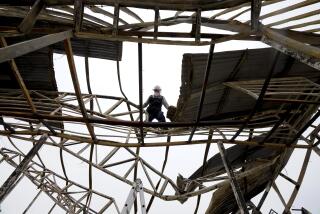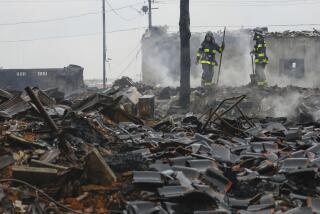Death toll nears 500 in 8.0 quake off Peru
LIMA, PERU — The death toll in a massive earthquake that battered Peru’s Pacific coast soared toward 500 on Thursday as rescue workers struggled to reach scenes of devastation and stunned victims appealed for medical aid, water and coffins.
Teams dug beneath the rubble in the cities of Pisco and Ica and the nearby town of Chincha, all situated near the epicenter of the magnitude 8.0 quake south of the capital, Lima. The damage and casualties appeared to be concentrated in those three communities, which also lost power and telephone service.
“Our city is destroyed,” Mayor Juan Mendoza of Pisco, a port city of about 130,000 people, said, sobbing in an interview with Peruvian news media. “The dead are scattered by the dozens on the streets.”
Mendoza estimated that 70% of the structures in his city had been leveled. Other officials said about 200 people were believed to have died in Pisco.
Authorities also said that a majority of buildings were destroyed in the city of Ica, just to the southeast. The mayor of that city, Mariano Nacimiento, estimated the death toll there at 70 and said that about 800 residents had been injured.
“We need medicines, tents, food and whatever help there is,” he told Peruvian media.
The National Civil Defense Institute’s director of operations, Aristides Mussio, told reporters that the overall death toll stood at 437 and that more than 16,000 homes had been destroyed.
The quake struck Wednesday evening when many people were in church for services marking the Roman Catholic holy day of the Feast of the Assumption.
After an evening when many strong aftershocks were recorded, residents of the quake- ravaged region awoke Thursday to a catastrophic panorama of collapsed buildings, ruined roadways, fallen lampposts and dazed survivors.
“Sir, we are afraid,” Marina Yupanki, 32, an Ica resident whose adobe home had been destroyed, told a reporter for Canal N, a cable TV news station. “We are sick; we are seeking help for our children.”
Others said they were afraid to return to their homes, worried about new temblors and collapses.
“We are not going back in our houses again,” Clara Obregon, 65, of Ica, told Canal N. “We plan to stay out here on the streets. We want tents and something to eat. We haven’t eaten.”
President Alan Garcia flew to Pisco to find residents pleading for medical aid, water and coffins. Many corpses remained on the streets early Thursday, in some cases watched over by relatives, the media reported.
At least 17 of the dead in Pisco were reported to have perished when two churches collapsed during evening services. Peruvian television showed images of dazed residents lingering in the city’s central plaza and amid ruins. Many wrapped themselves in blankets against the desert chill of the Southern Hemispheric winter.
Garcia declared that he would stay until aid and rescue problems were solved.
“Please wait; have patience,” he told an imploring crowd. He declared the area a disaster zone.
Hospitals in the worst-hit regions were overwhelmed. Patients were being treated in hallways and in makeshift aid centers set up outside. The air force and commercial airlines where planning flights to ferry the injured to hospitals in Lima and elsewhere.
Pledges of help came from many aid agencies and foreign governments.
President Bush and his wife, Laura, offered their condolences. Gordon Johndroe, a deputy White House spokesman, told reporters in Crawford, Texas, where the Bushes are vacationing at their ranch, that “the United States stands ready to assist Peru, and is willing to provide assistance based on the needs identified by the government of Peru, as well as United States government teams there.”
He said a team from the U.S. Agency for International Development had begun assessing the situation in Lima and that search-and-rescue teams were “on standby should they be needed.”
Rescue efforts were being hampered by damage to roads. Officials reported deep cracks in highways and boulders blocking access on major roads to the south, the result of landslides.
The damaged roads also thwarted efforts by worried relatives to drive to the hardest-hit areas to check on loved ones.
During the confusion of the quake’s aftermath, hundreds of prisoners were reported to have fled from a prison in Chincha.
“It was really hard to control all the prisoners,” Manuel Aguilar, vice president of Peru’s prison authority, told the Reuters news agency.
A major shrine in Ica, the 17th century Church of Nuestro Señor de Luren, also was damaged, but it was not clear whether anyone inside was hurt.
“We’re still not sure if there were victims,” said Father Carlos Henao. A church bell tower collapsed, he said, but a revered image of Jesus apparently came through intact.
Officials reported hundreds of aftershocks, including jolts early Thursday measuring 6.0.
As the aftershocks continued, the U.S. Geological Survey upgraded the magnitude of the Wednesday evening quake to 8.0 from 7.9.
By comparison, the 1906 San Francisco earthquake is estimated at a magnitude of 7.8 to 8.25. The magnitude 6.7 Northridge quake in 1994 was much smaller but caused more than $40 billion in damage. Each change of 1 magnitude increases ground motion by 10 times and releases about 32 times more energy, according to the USGS.
The temblor Wednesday was centered in the Pacific about 90 miles southeast of Lima, at a depth of about 25 miles, authorities said.
The shaking was felt along a wide swath of coastal Peru, including the capital, where thousands of residents fled their houses Wednesday and early Thursday. Three fatalities were reported in the Lima area from heart attacks, authorities said.
“We don’t know how long the aftershocks will continue, but it’s sure that they will continue,” Hernando Tavera, director of seismology at the Geophysical Institute of Peru, told the Andina press agency.
Authorities here said that the earthquake was the region’s deadliest since a magnitude 7.9 quake struck north of Lima in 1970, causing more than 50,000 deaths.
--
Special correspondent Leon reported from Lima and Times staff writer McDonnell from Sao Paulo, Brazil. Andres D’Alessandro of The Times’ Buenos Aires Bureau and staff writer Bob Drogin in Crawford, Texas, contributed to this report.
More to Read
Sign up for Essential California
The most important California stories and recommendations in your inbox every morning.
You may occasionally receive promotional content from the Los Angeles Times.










